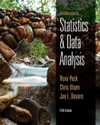
Roxy Peck, Chris Olsen, and Jay Devore's 5th edition of
Introduction to Statistics, published by
Cengage Learning, uses real data and attention-grabbing examples to introduce students to the study of statistics and data analysis. Traditional in structure yet modern in approach, this text guides students through an intuition-based learning process that stresses interpretation and communication of statistical information. The WebAssign component for this text engages students with an interactive eBook and several other resources.
Question 2 requires the student to calculate the frequency and relative frequency from a table of values, then construct, analyze, and infer information from the histogram to estimate a particular frequency.
Questions 4, 5, and 6 show a variety of questions about probability and counting techniques.
Question 7 is an Active Example from the textbook that walks the student through how to calculate a particular
P-value for a normal distribution.
Question 8 provides a link to the appendix tables available in the textbook that the student may use to calculate confidence intervals; however, the student may also use technology to calculate the value.
Questions 9 and 10 ask the students to analyze different hypothesis tests.
Question 11 asks the student to calculate the equation for the regression line and then compute values associated with the regression.
Question 12 demonstrates a single-factor ANOVA
F test.
Question 13 is a Stats in Practice Question that demonstrates the use of videos displayed within a question, followed by multiple-choice and discussion questions in a unique two-part accordion-style type of display.
Question 14 is a Test Bank question that highlights the ability to grade short answer style questions automatically using multiple choice.
Question 15 is a Simulation Question utilizing the JMP Applet.
Question 16 is an example of a Statistical Lab.
Question 17 highlights Milestone 1, the first step in presenting and tracking Project Milestones for a statistical research project.
This demo assignment allows many submissions and allows you to try another version of the same question for practice wherever the problem has randomized values.
| The answer key and solutions will display after the first submission for demonstration purposes. Instructors can configure these to display after the due date or after a specified number of submissions. |